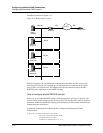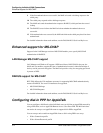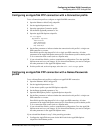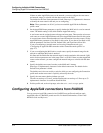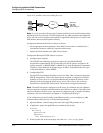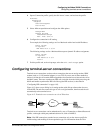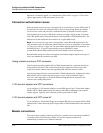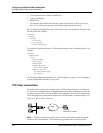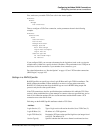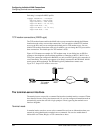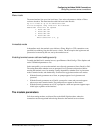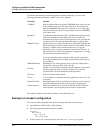
4-78 MAX 6000/3000 Network Configuration Guide
Configuring Individual WAN Connections
Configuring terminal-server connections
Options in a Connection profile, see “Introduction to WAN links” on page 4-2. These Telco
options apply equally to PPP and terminal-server calls.
Connection authentication issues
When the terminal server receives a forwarded call, it waits briefly to receive a PPP packet. If
the terminal server times out waiting for PPP, it sends its login prompt. When the terminal
server receives a name and password, it authenticates them against the Connection profile.
If the terminal server receives a PPP packet, instead of sending a Login prompt, it responds
with a PPP packet and LCP negotiation begins, including PAP or CHAP authentication. The
terminal server then establishes the connection as a regular PPP session.
Note: If you do not want your users to share profiles, set the Shared Prof parameter to No.
This parameter can be set in Ethernet > Mod Config for all users or in Ethernet > Connections
> Connection profile for a single user. For more details about the Shared Prof parameter, see
the MAX Reference. To specify shared profiles per user in RADIUS, see the
Ascend-Shared-Profile-Enable attribute in the TAOS RADIUS Guide and Reference.
Recommended settings for callers with modems and terminal adapters depend on the type of
device and whether the connection uses PPP.
Analog modems and async PPP connection
If the Connection profile specifies PAP or CHAP authentication for connections through an
analog modem, the caller’s PPP software should not be configured with any expect-send
scripts, because the software must start negotiating PPP when the modems connect.
If the Connection profile does not specify PAP or CHAP authentication, configure the caller’s
PPP software with an expect-send script (expect > Login: send <$username> expect
Password: send <$password:>). When the MAX unit authenticates the connection, the
software starts sending PPP packets.
V.120 terminal adapters and PPP connections
If you configure a V.120 terminal adapter to run the PPP protocol, the V.120 terminal adapter
handles PAP or CHAP authentication and whatever other PPP or MP features the terminal
adapter supports. Typically, the Connection profile requires PAP or CHAP.
V.120 terminal adapters with PPP turned off
If you configure a V.120 terminal adapter to run without PPP, it does not support PAP or CHAP
authentication. If the Connection profile requires PAP or CHAP authentication, the connection
fails.
Modem connections
This section shows sample Connection profiles for a terminal-server connections established
via analog modem. The following example uses only the required parameters for
authenticating a terminal-server modem connection:



